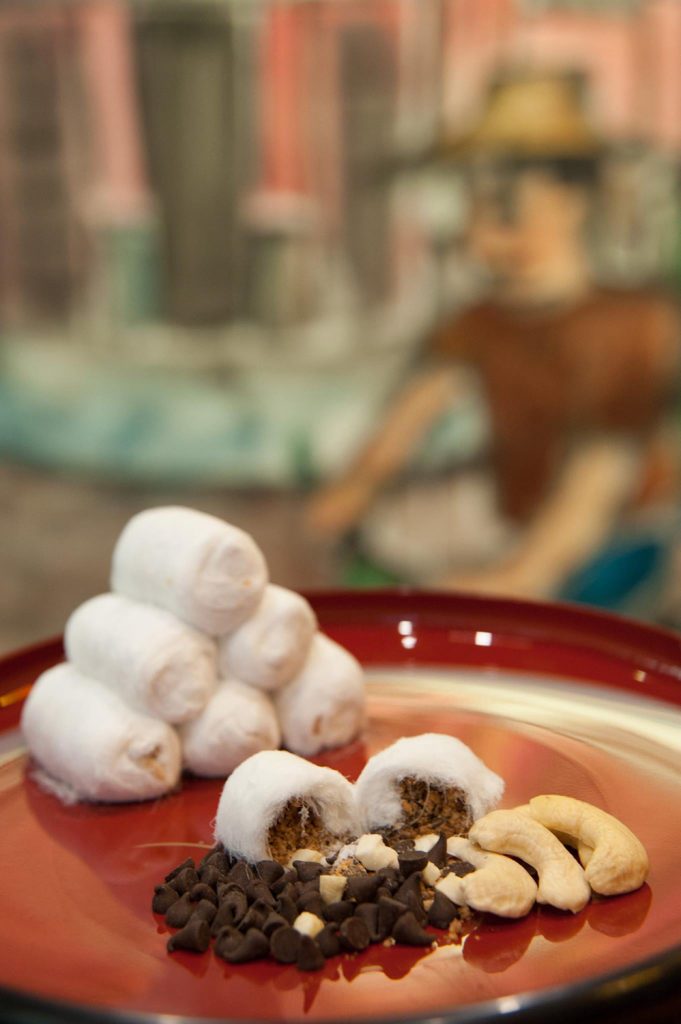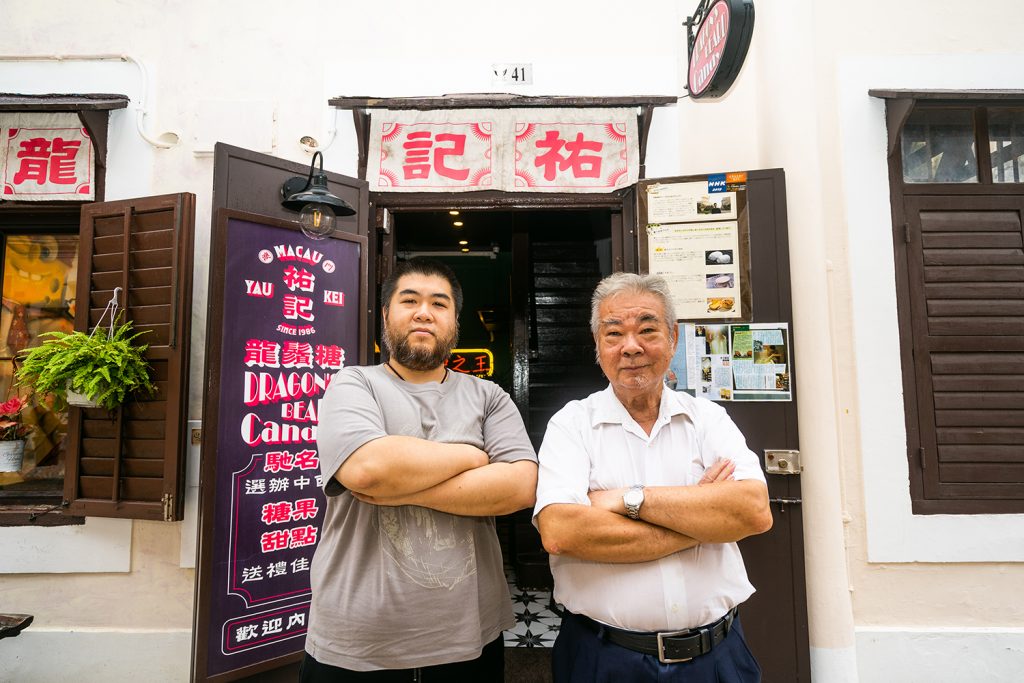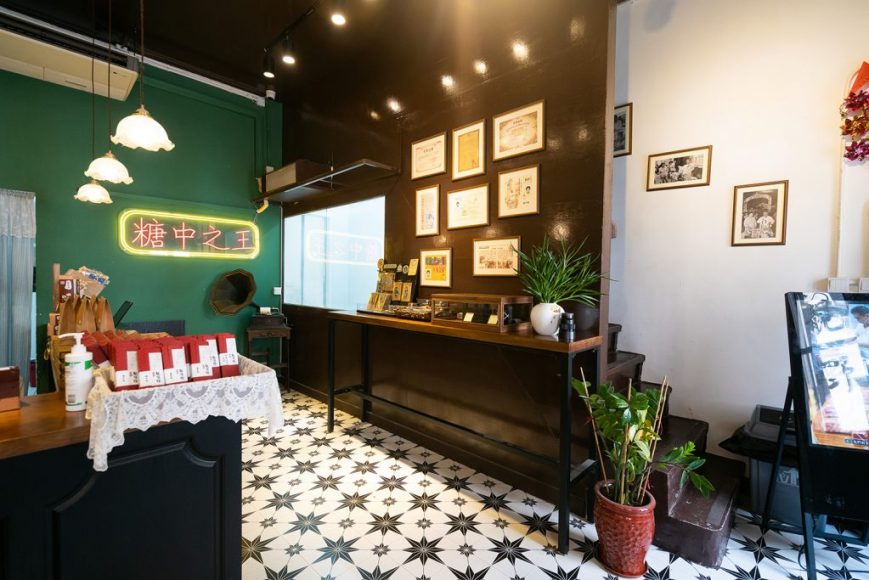Kenny Yuen stands in a temperature-controlled room inside Yau Kei Candy shop, holding a giant ring of hardened, malleable malt sugar dusted in a thick layer of cornstarch.
Slowly, Yuen starts to pull at this ring. He twists the sugar into a figure eight, loops the candy back and around, and then repeats the movement. The ring becomes two, then four, eight, 16, 32. After 15 minutes of doing this, Yuen gives it a final pull, and suddenly he holds over 16,000 strands of sugary silk in the shape of a ‘dragon’s beard’ in his hand. He takes these filament-thin strands and wraps them around a sweet filling made from peanuts, sesame and coconut, and the circle is closed.
“I usually spend all day making the candy,” says Yuen. “It can be hard on the hands, but I’ve been doing it for 12 years now, so it’s all just muscle memory.”
The 40-year-old candy maker is one of the last in Macao still creating the sweet treat the old-fashioned way. It’s a life he never envisioned for himself. But he can thank his father, Yuen Tin Yau, for not just igniting his interest in the traditional craft, but also for keeping the ancient art alive today.
The tale of the dragon

A silky confection once enjoyed only by the ruling elite, thanks to its time-consuming preparation, dragon beard candy is said to have originated in China during the Han dynasty, although the legend surrounding its creation is as wispy as the candy itself. Some say that an imperial court chef created the sweet treat for the emperor; the small sticky strands clung to his face after he ate it, and so he christened it ‘dragon beard’ candy. Others believe the candy was simply named after the mythical dragon – the symbol of the Chinese emperor.
Yuen Tin Yau, founder of Yau Kei Candy, tells a different story. “The original name was ‘silver thread candy’,” he says. “The emperor liked the candy so much, and as his zodiac sign was the dragon, he renamed it dragon beard candy.”
The sweet eventually escaped the confines of the Forbidden City and made its way into the public domain. For decades, the secrets of the candy-making process were passed down orally, and vendors sold it on street corners throughout the country. But when the Chinese Cultural Revolution attempted to eradicate any connection with the country’s imperial past, the tradition nearly disappeared. It wasn’t until 1976, when the revolution came to an end, that the candy started to make a slow but noticeable comeback.
At the time, Yuen Tin Yau, who was born in Macao in 1947, was living in Hong Kong, where he had relocated with his family in the 1970s. “The manufacturing industry in Hong Kong was declining and my housemate and fellow apprentice and I were eager to change jobs,” he explains. “One day, he told me that he had got a recipe for making dragon beard candy and I asked him if he could teach me as well. But he told me that he would make the candy and I could sell them.”
So rare and treasured were the secrets of dragon beard candy that Yuen Tin Yau’s housemate refused to share his recipe and candy-making techniques. He would only make the candy when Yuen Tin Yau was out and even tore the labels off product packaging so he couldn’t replicate the recipe. But his housemate’s efforts were no match for Yuen Tin Yau’s curiosity.

“I collected all those scraps of paper and tried to piece together what he was using,” he says. “I finally figured out the ingredients [corn syrup, shredded coconut, peanuts and sesame] and tried to make my own candy. It gave me blisters all over my hands, because I had no idea what I was doing.”
Even with a straightforward recipe in hand, it took time for Yuen Tin Yau to figure out the process. He had to pour molten malt-sugar syrup, heated to a scalding 171 degrees Celsius, into containers and let them cool overnight before he could start pulling them into strands. It took him months to learn the process and years to perfect it.
In 1976, then 28 years old, Yuen Tin Yau moved in with his older brother and started running a dragon beard candy hawker stall in Tsuen Wan. “I actually bumped into my old housemate one day and he invited me to start a business with him,” says Yau. “But I was already selling my own candy by then and didn’t need to go into partnership with him.”
After selling his candy in Hong Kong for 10 years, Yuen Tin Yau returned to Macao in 1986 to try his luck here. He set up shop outside Theatre Alegria in the St Anthony district. “It became unexpectedly popular. Business was steady and everyone here grew to love the candy very much,” he says. “The process is quite theatrical to watch, and then the way it just dissolves in the mouth is almost magical.”
Copycat stalls began to pop up around town, but Yuen Tin Yau says they had all disappeared by the end of the decade. “Nobody wanted to take over the businesses,” he explains. “Without someone to learn the trade and keep things going, they had to shut down.”
Yuen Tin Yau nearly suffered the same fate.
Keeping traditions alive

Nearing retirement, the ageing candy maker could feel the years catching up with him – the repetitive movements, the strain on his body. He started receiving cortisone injections in his hands to manage the pain. When he turned 65 years old, he finally pleaded with his son Kenny to take over the family business.
“I was in the UK studying biology when my father asked me to take over,” says the younger Yuen. “I didn’t want to do it. But I asked my friends what they thought, and they said if I didn’t do it then there would be no more dragon beard candy in Macao, and it will be lost forever once my father retires.”
Yuen agreed to a one-year trial. In 2010, he returned to Macao to learn the tricks of the trade from his father. “It’s easy to say you’ll give it a go and see, but once you pick it up, it’s difficult to stop,” he says with a laugh.
Despite spending his whole childhood watching his father perform the intricate movements to make the delicate candy, Yuen found it difficult to produce it properly with his own hands. That’s because he was trying to mimic Yuen Tin Yau’s movements. “He told me that I had to learn my own way to make the candy,” says Yuen. “Once I started using my own style to make it, it became a lot easier to perfect.”
His efforts have not gone unnoticed.
The peanut-filled candy was added to the Macao government’s Inventory of Intangible Cultural Heritage in 2020, and now some of Macao’s hotels offer it as an in-room treat for their guests. Even if the candy evolves with the times – new fillings, new packaging, new production facilities – the recognition from the government should provide on-going protection of the centuries-old tradition.

And Yuen makes it clear that those changes are occurring.
“We have some new flavours now like durian, tofu, chocolate ice cream, plum, and lychee tea,” he says. “It brings a creative and modern element to the candy that will keep it relevant.”
New technology has helped extend its lifespan, too. Sensitive to temperature and moisture, the treat that Yuen Tin Yau once hawked on the streets of Hong Kong and Macao had to be consumed immediately or else it would melt. Now, Yuen makes the candy inside a temperature-controlled room at the company’s brick-and-mortar shop in the St Lazarus district.
“Now we don’t have to worry about the weather affecting our candy,” says Yuen. “My father still talks about a day in Hong Kong when they were hit by a sudden hail storm and none of the dragon beard candy makers could pull the candy – the unpredictable weather just made it impossible.”
That leaves Yuen with time to find others to carry the torch in the future. In an effort to get ahead of the ball, he runs workshops on the upper level of the shop to teach others how to make the candy and, he hopes, generate interest in the craft. He might not have to look far to find someone to keep dragon beard candy alive for the next generation, though. His son, 10, has already declared that he will one day take over the candy empire. “We’ll see!” Yuen says with a laugh. “I won’t put any pressure on him.”



